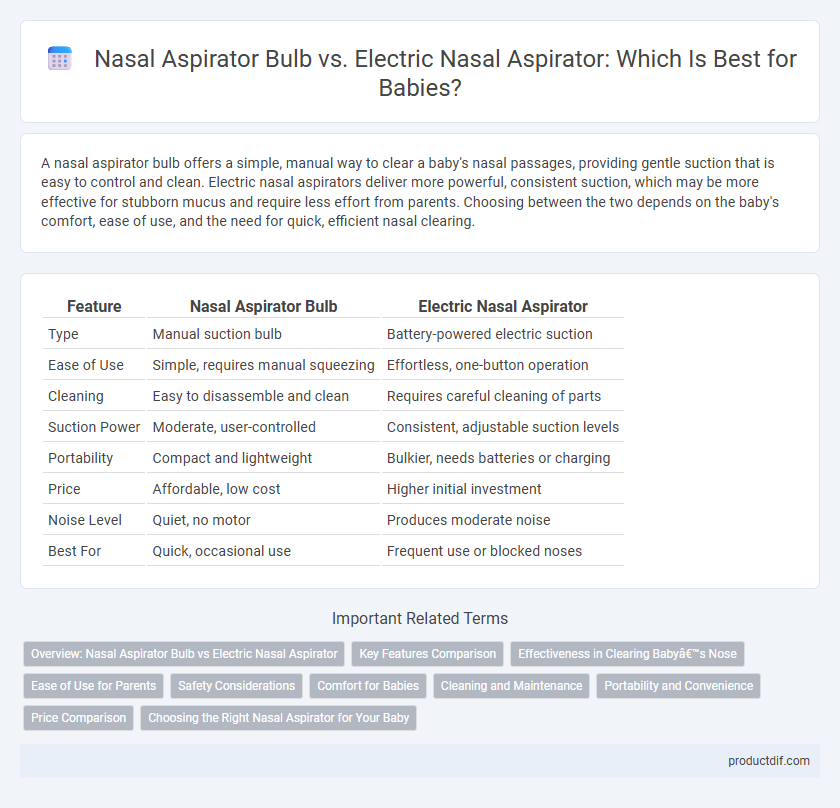A nasal aspirator bulb offers a simple, manual way to clear a baby's nasal passages, providing gentle suction that is easy to control and clean. Electric nasal aspirators deliver more powerful, consistent suction, which may be more effective for stubborn mucus and require less effort from parents. Choosing between the two depends on the baby's comfort, ease of use, and the need for quick, efficient nasal clearing.
Table of Comparison
| Feature | Nasal Aspirator Bulb | Electric Nasal Aspirator |
|---|---|---|
| Type | Manual suction bulb | Battery-powered electric suction |
| Ease of Use | Simple, requires manual squeezing | Effortless, one-button operation |
| Cleaning | Easy to disassemble and clean | Requires careful cleaning of parts |
| Suction Power | Moderate, user-controlled | Consistent, adjustable suction levels |
| Portability | Compact and lightweight | Bulkier, needs batteries or charging |
| Price | Affordable, low cost | Higher initial investment |
| Noise Level | Quiet, no motor | Produces moderate noise |
| Best For | Quick, occasional use | Frequent use or blocked noses |
Overview: Nasal Aspirator Bulb vs Electric Nasal Aspirator
Nasal aspirator bulbs are manual devices that rely on gentle suction created by squeezing the bulb to clear a baby's nasal passages, offering a simple, portable, and affordable option. Electric nasal aspirators provide consistent and adjustable suction power through battery operation, ensuring efficient and quick removal of mucus with minimal effort. Choosing between the two depends on preferences for ease of use, hygiene, and effectiveness in managing nasal congestion in infants.
Key Features Comparison
Nasal aspirator bulbs offer simplicity, portability, and quiet operation, making them ideal for quick, gentle suction without the need for batteries or charging. Electric nasal aspirators provide adjustable suction power, ease of use through one-handed operation, and often include removable, easy-to-clean components for improved hygiene. Parents should consider factors like suction strength, noise level, and maintenance when choosing the best nasal aspirator to clear their baby's nasal passages effectively.
Effectiveness in Clearing Baby’s Nose
Electric nasal aspirators deliver stronger suction power compared to traditional bulb aspirators, making them more effective at clearing a baby's congested nose quickly and thoroughly. Bulb aspirators rely on manual pressure, which often results in inconsistent suction and may leave mucus behind. Many parents report electric aspirators reduce discomfort and improve breathing by efficiently removing nasal blockages.
Ease of Use for Parents
Electric nasal aspirators offer parents hands-free operation and adjustable suction levels, making it easier to clear a baby's nasal passages efficiently. Bulb aspirators require manual squeezing, which can be less precise and more time-consuming, especially with a fussy infant. The ergonomic design and faster performance of electric models significantly reduce stress and effort during nasal suction.
Safety Considerations
Nasal aspirator bulbs are favored for their simplicity and gentle suction, reducing the risk of nasal tissue irritation in newborns and infants. Electric nasal aspirators provide stronger suction and efficiency but require careful use to avoid potential nasal mucosa damage or discomfort. Parents should prioritize devices with adjustable suction levels and soft, hypoallergenic tips to ensure safe and effective nasal clearance.
Comfort for Babies
A nasal aspirator bulb offers gentle suction that is typically soft on a baby's delicate nasal passages, minimizing discomfort during use. Electric nasal aspirators provide adjustable suction power, allowing for effective mucus removal with less effort, but improper settings may cause irritation. Parents often choose bulb aspirators for newborns due to their simplicity and softness, while electric models suit older babies needing stronger suction with comfort features like silicone tips.
Cleaning and Maintenance
Nasal aspirator bulbs require thorough cleaning after each use by rinsing with warm, soapy water and allowing them to air dry to prevent mold and bacteria buildup. Electric nasal aspirators often feature detachable parts that are dishwasher-safe or can be sterilized easily, ensuring more hygienic maintenance. Regular cleaning of both types is essential to ensure safe and effective removal of nasal mucus in infants.
Portability and Convenience
Manual nasal aspirator bulbs are highly portable due to their lightweight, compact design, making them easy to carry in diaper bags or purses for on-the-go use. Electric nasal aspirators, while offering efficient and powerful suction, tend to be bulkier and require batteries or charging, which can limit convenience during travel. Parents often prefer bulb aspirators for quick, uncomplicated use, whereas electric models suit home settings where portability is less critical.
Price Comparison
Manual nasal aspirator bulbs are significantly more affordable, typically ranging between $5 and $15, making them a budget-friendly option for parents. Electric nasal aspirators, priced between $25 and $60, offer advanced suction power and ease of use but come with a higher initial investment. The price difference reflects the technology and convenience provided, with electric models often including rechargeable batteries and multiple suction settings.
Choosing the Right Nasal Aspirator for Your Baby
Choosing the right nasal aspirator for your baby depends on convenience, effectiveness, and comfort. A nasal aspirator bulb is simple, quiet, and affordable, making it ideal for occasional use and newborns sensitive to noise. Electric nasal aspirators offer powerful suction and adjustable settings, providing quick and thorough mucus removal for frequent use or older babies with more congestion.
Nasal aspirator bulb vs electric nasal aspirator Infographic

 productdif.com
productdif.com